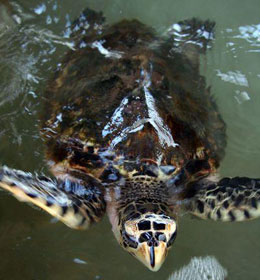Sea turtles use Earth’s magnetic field to return to nesting beaches
Sea turtles use Earth’s magnetic field to return to nesting beaches
mongabay.com
February 27, 2007
New research suggests that sea turtles use a “relatively simple navigation system” involving the Earth’s magnetic field to return to the same beaches to lay their eggs, even after venturing across thousands of miles of open ocean without visible landmarks.
Writing in Current Biology, an international team of scientists used satellite transmitters to remotely track turtles as they moved to and from nesting sites. They found that turtles find their way back to the same beaches, independent of ocean currents or other impediments.
“It is almost as if they were equipped with a compass pointing towards the beach in question,” noted a news release from the Center for Functional and Evolutionary Ecology at Montpellier, France. “They can correct any deflection they are subject to: transport by boat, ocean currents. But, unlike human navigators, they are not able to correct for ocean drift in plotting their course. So the movements recorded by the satellite are a combination of deliberate action by the turtles and the effect of currents.”
“It appears that the turtles’ navigation system is relatively simple and may cause them to be wander at sea for long periods during adverse ocean conditions,” the release continued. “One turtle released 250 km from its egg-laying site on Europa traveled more than 3 500 km in two months before returning there!”
 Photo by Rhett A. Butler. More news on sea turtles. |
The researchers confirmed the role of Earth’s magnetic field on turtle navigation by using a powerful magnet to disrupt the turtle’s orientation.
“Turtle navigation is not as good… when this field is disturbed,” the researchers report.
Still the authors note that even with the magnet attached to their cranium, turtles were still able to find their way home, suggesting there could be another overlooked source of information used in navigation.
“Turtles may also use their sense of smell like certain sea birds or homing pigeons,” stated the release, but “this hypothesis remains to be proven.”
The researchers say their work my improve conservation strategies for sea turtles by helping biologists better understand migration between nesting sites and feeding grounds.
Citation: Luschi P., Benhamou S., Girard C., Ciccione S., Roos D., Sudre J. & Benvenuti S. 2007. Marine turtles use geomagnetic cues during open-sea homing. Current Biology 17. 23 January 2007.
This article is based on a news release from he Center for Functional and Evolutionary Ecology at Montpellier, France